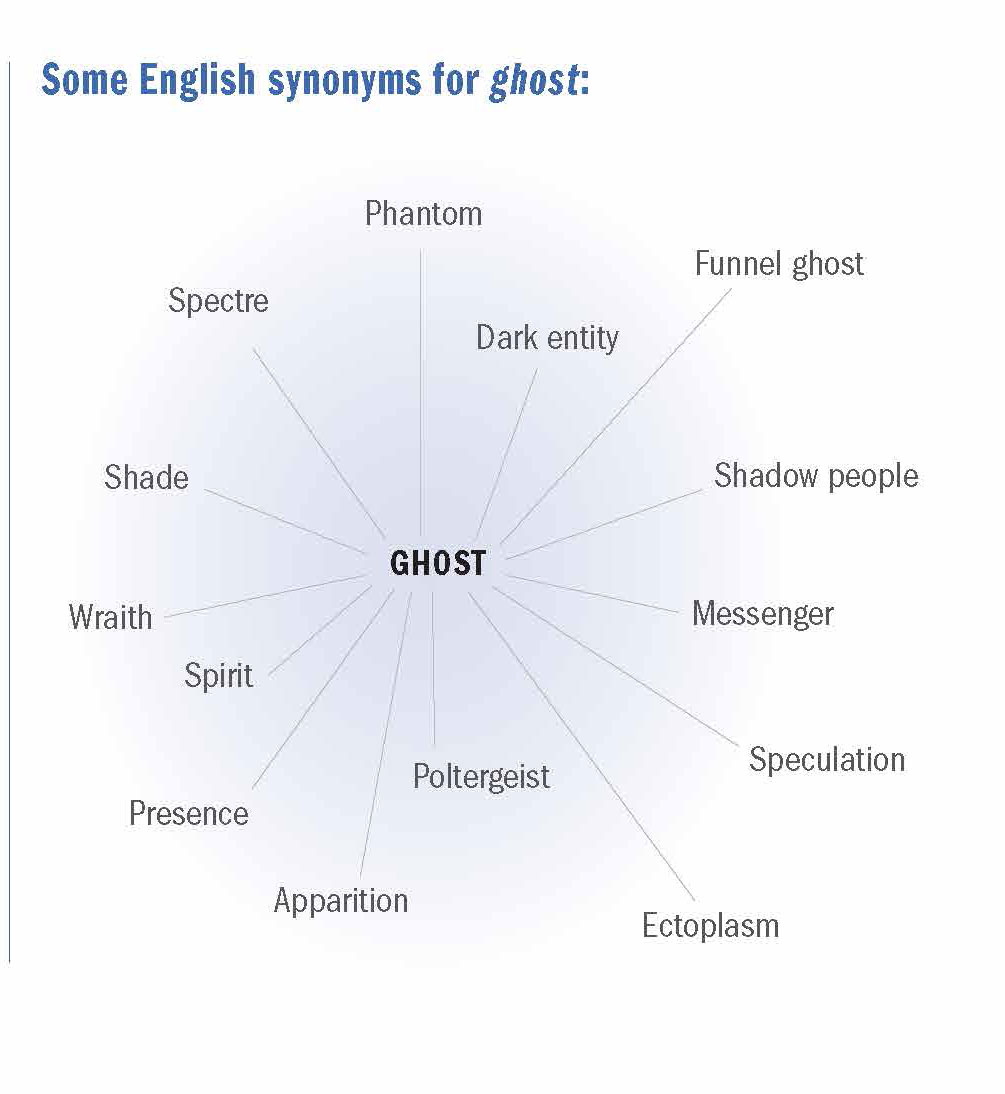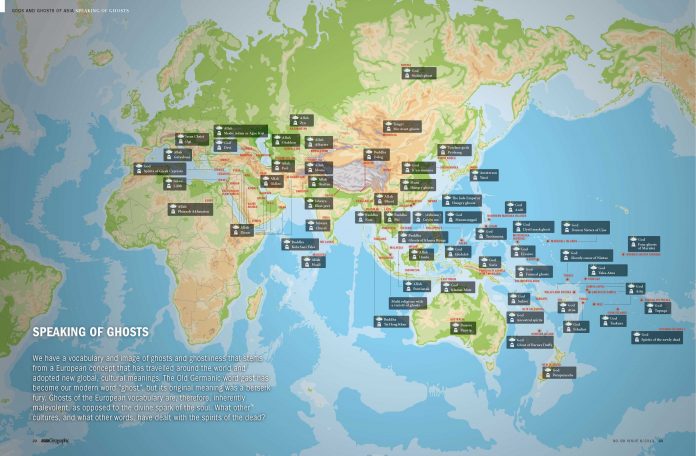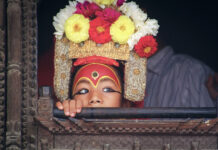We have a vocabulary and image of ghosts and ghostliness that stems from a European concept that has travelled around the world and adopted new global, cultural meanings. The Old Germanic word gast has become our modern word “ghost”, but its original meaning was a berserk fury. Ghosts of the European vocabulary are, therefore, inherently malevolent, as opposed to the divine spark of the soul. What other cultures, and what other words, have dealt with the spirits of the dead?
• The HAWAIIANS speak of aumakuas, the benevolent ancestral ghosts. The word aumakua means “many ancestors” and can serve as a reminder of how many generations of parents lead to an individual. After death, the aumakua would exit from the eyes of the corpse and travel to other places. The living might enter their recently deceased in the ocean or in the lava craters of the Hawaiian volcanoes, perhaps to be reincarnated as an underwater spirit or fiery deity. Besides the aumakuas, there were dangerous demon kupuas, spirit helpers menehune and the weak but friendly eepa.
• The MAORI of New Zealand believe that the spirits of their ancestors left this mortal world via the branches of an ancient Pohutakawa tree (Metrosideros excelsa) at the northernmost point of the North Island. Their journey from life must be accompanied by the appropriate prayers and rituals performed by their surviving family. There are also malicious ghosts, such as the insanity-inducing kikokiko or forest-dwelling maero spirits.
• To the cultures of the INDIAN SUBCONTINENT, the restless, malevolent spirits of the deceased are known as bhoot and can be recognised by their twisted ankles and their avoidance of the sacred earth. While they are attracted to milk, they are wary of iron or water. The Sanskritic etymological origin of the word bhoot is related to that of the English word “being”.
• In EGYPT, the multiple aspects of the living person’s soul fused after death to form a sacred spirit, the akh. Sometimes, this akh would remain in and around the tomb and could become involved with the living world by helping their descendants, or haunting others with dreams and disease.
• To the Navajo people of the NORTH AMERICAN SOUTHWEST, the remnant evil of a person haunts the house in which they died and are summoned when their living name is spoken. They can be sometimes seen as small whirlwinds of dust and sand.
• To the Aztecs of MEXICO, the manner of one’s death determined one’s fate. For women who died in childbirth, their spirit would return to the world, seeking the child they were never granted. In modern-day Mexico, ancient Aztec beliefs have fused with Roman Catholicism in unique ways. On the day after All Hallow’s Eve (Halloween), the dearly departed are respected and remembered; throughout Mexico people visit their family graves and celebrate their memory.
• To CHINESE BUDDHISTS, the ancestral e-kuei ghosts are associated with frustration, as they can never successfully assuage their thirst or hunger. Prayers and rituals may help to release these poor spirits from their torture.
• TIBETAN BUDDHISTS believe that between reincarnations, a soul remains in the bardo state of afterlife as a preta, eternally hungry and unsatisfied. A yearly festival is held in midwinter, where ceremonies are performed to ritually exorcise ghosts.
• In ancient JAPANESE culture, the reikon spirit of a deceased human becomes a guardian ancestor spirit. However, it can be trapped as a yūrei in this world by violent, unjust or improper death. There are many different classifications of yūrei for those lost in childbirth, those needing vengeance, those lost at sea, and more. Japanese Buddhists also believe in hungering ghosts, as well as jikininki, who are the self-hating spirits of the dead with a longing for human flesh.
• In WESTERN AFRICA and the CARIBBEAN ISLANDS, the duppy is the half of a deceased’s soul that stays on Earth –the other half goes upwards to divinity. Stories are told of their fiery eyes and teeth.
• The MALAYSIAN word for ghost is hantu, and has been combined with the Muslim concept of djinn. Traditionally, the anitu spirit is present at the burial site for seven nights and may cause grief to the living until exorcised or pacified. There are varieties of hantu associated with stillborn children, women lost in childbirth, and sorcery exercises.

EAST ASIA
CHINA, HONG KONG, MACAU
GOD
Mazu: A folk goddess of the sea that protects sailors and fishermen. She started out as a local folk goddess but has entered the Taoist and Buddhist pantheon. Also known as Tianhou or Tinhau in Hong Kong.
SOURCE: NATIONAL PUBLIC RADIO
CHINA, HONG KONG, MACAU, TAIWAN
GHOST
Hungry ghosts: The spirits of persons who have committed the sin of greed while they were alive. It is also believed that they can emerge from neglect or desertion of ancestors.
SOURCE: TAOISM: ORIGINS, BELIEFS, PRACTICES, HOLY TEXTS, SACRED PLACES BY J. OLDSTONE-MOORE
TAIWAN
GOD
The Jade Emperor: The ruler of Heaven, Earth and Hell. He was proclaimed supreme sovereign of all by immortals, gods and men by defeating a great and powerful demon too powerful to be stopped by the other gods.
SOURCE: GODS OF TAOISM
JAPAN
GOD
Amaterasu: Goddess of the sun and the universe. The meaning of her whole name, Amaterasu-ōmikami, is “the great august kami (Gama or God) who shines in the heaven”.
The Emperor of Japan is said to be her direct descendant.
SOURCE: JAPANESE MYTHOLOGY A TO Z
GHOST
Yūrei: Analogous to Chinese and Western ghosts, spirits kept from a peaceful afterlife. They usually appear dressed in white, with long, black and dishevelled hair. They lack hands and feet.
SOURCE: TAOISM: ORIGINS, BELIEFS, PRACTICES, HOLY TEXTS, SACRED PLACES BY J. OLDSTONE-MOORE
MONGOLIA
GOD
Tengri: One of the names of the primary chief deity of the early Turkic peoples. He is the creator of all things, and father to the sun and the moon.
SOURCE: ANIMAL AND SHAMAN: ANCIENT RELIGIONS OF CENTRAL ASIA BY J. BALDICK
GHOST
Merchant ghosts: Long-bearded old men dressed in silken clothes, ghosts of merchants who come back to reclaim goods they could not take with them in the beyond.
SOURCE: PARASITIC CHINESE, VENGEFUL RUSSIANS: GHOSTS, STRANGERS, AND RECIPROCITY IN MONGOLIA BY G. DELAPLACE
SOUTH KOREA
GHOST
K’un manura: Spiteful, jealous or dissatisfied spiritual apparitions of first wives frequently manifest in shaman rituals. Also known as “big wife” or “major wife”, their emotional experiences persist in restless ancestors.
SOURCE: WIVES, LESSER WIVES, AND GHOSTS: SUPERNATURAL CONFLICT IN A KOREAN VILLAGE BY L. KENDALL
NORTH KOREA
GOD
Tutelary gods: An unorganised pantheon of gods that inhabit trees, sacred caves, piles of stones, and oversee households and villages. They can be summoned during shamanic rituals, where they possess the shaman.
SOURCE: KOREAN SHAMANISM – MUISM BY T-G KIM
GHOST
Pyolsang: Ghosts of deceased individuals who met with violent or tragic ends. They cause illnesses and bad fortune to their victims. They can be exorcised by shamans.
SOURCE: FOLK-RELIGION: THE CUSTOMS IN KOREA BY C-S CHLOE
NORTH ASIA
RUSSIA
GOD
God: An incorporeal, omnipresent spirit – a Trinity of the Father (God), the Son (Christ), and the Holy Spirit that comprises one God Almighty. SOURCE: BELIEFNET GHOST Ghost of Joseph Stalin: The country’s former leader is said to be the Kremlin’s most frequently seen ghost. He often appears in times of national crisis with witnesses claiming that the ghost wants to establish order.
SOURCE: ASTROLOGYGUIDE.COM
WEST ASIA
ARMENIA
GOD
Jesus Christ: Members of the Armenian Apostolic Church believe that Jesus Christ is God, that he is one being with dual natures, human and divine.
SOURCE: SYRIAN ORTHODOX RESOURCES
GHOST
Ogi: Synonymous with Armenian words for “breath” (shunch’) and “soul” (hogi). An evil spirit in Armenian folklore exits a dead body from the mouth, and can do harm by entering another person and causing diseases.
SOURCE: ARMENIAN FOLK BELIEFS
AZERBAIJAN, BAHRAIN, IRAQ, KUWAIT, JORDAN, LEBANON, PALESTINIAN TERRITORIES, OMAN, SYRIA, TURKEY, UNITED ARAB EMIRATES, YEMEN
GOD
Allah: The supreme deity, creator of the earth and giver of water, interpreted by the Prophet Muhammad as the one true God to which men should submit.
SOURCE: THE ROUTLEDGE DICTIONARY OF GODS AND GODDESS, DEVILS AND DEMONS
CYPRUS, GEORGIA
GOD
God: An incorporeal, omnipresent spirit – a Trinity of the Father (God), the Son (Christ), and the Holy Spirit that comprises one God Almighty.
SOURCE: BELIEFNET
AZERBAIJAN
GHOST
Meshe Adam/Ağac Kişi: A spirit that lives in mountainous forests, it looks like a hairy creature of both sexes and possesses intermediate facial features between an ape and a human’s.
SOURCE: СоветСкая энциклопедия (SOVIET ENCYCLOPEDIA)
BAHRAIN, IRAQ, KUWAIT, JORDAN, LEBANON, PALESTINIAN TERRITORIES, OMAN, QATAR, SAUDI ARABIA, UNITED ARAB EMIRATES, YEMEN
GHOST
Djinn: Central to the Muslim worldview, djinns belong to a class of demonic beings or nature spirits that goes back to pre-Islamic times. Many Iraqis believed that seven djinns protected Saddam Hussein from harm, and that he spoke daily with the king and queen of the djinns on how to run the country and maintain power.
SOURCE: IRAQ: SUPERSTITIONS AND FOLKLORE AND THE ROUTLEDGE DICTIONARY OF GODS AND GODDESS, DEVILS AND DEMONS
CYPRUS
GHOST
Spirits of Greek Cypriots: These are the sprits of men killed at the time of the Turkish invasion in 1974. These ghostly figures, whose killers have never been punished, have a symbolic and political potency. SOURCE: NEWS.BBC.CO.UK
GEORGIA
GHOST
Devi: These have horns and multiple heads that regenerate if severed. They live in the underworld or remote mountains and hoard treasures.
SOURCE: FOLKLORE AND MYTHOLOGY
ISRAEL
GOD
Jahwe (Jahve): The name of the God of Israel. Jewish adherents believe they are commanded by Him to love one another as He does humankind.
SOURCE: THE ROUTLEDGE DICTIONARY OF GODS AND GODDESS, DEVILS AND DEMONS
GHOST
Lilith: Jewish legend has it that Adam had another partner, Lilith, before Eve. She turned down Adam’s sexual advances and was cursed. She takes vengeance by kidnapping children.
SOURCE: THALIATOOK.COM
SYRIA
GHOST
Ekimmu: The spirit of one who died a violent death or was denied entry into the underworld. Ekimmu walk the earth to haunt the living.
SOURCE: ENCYCLOPEDIA OF GHOSTS & SPIRITS
TURKEY
GHOST
Gulyabani: In Turkish mythology, the gulyabani roams the desert by night tormenting those brave enough to travel in the dark and is said to take on the hairy appearance of a werewolf by moonlight.
SOURCE: CAUCASIAN MYTHOLOGY, AZERBAIJANI MYTHOLOGY
AFGHANISTAN, BANGLADESH, IRAN, MALDIVES, PAKISTAN
GOD
Allah: The supreme deity, creator of the earth and giver of water, interpreted by the Prophet Muhammad as the one true God to which men should submit.
SOURCE: THE ROUTLEDGE DICTIONARY OF GODS AND GODDESS, DEVILS AND DEMONS
BHUTAN, SRI LANKA
ENLIGHTENED BEING
Buddha: Buddhists reject the concept of a supreme Creator God or at least consider it irrelevant. Buddha, a fully enlightened being, is revered instead.
SOURCE: BELIEFNET
INDIA, NEPAL
GOD
Ishvara: Also worshipped as Vishnu, Brahma, Shiva, or Shakti, depending on the Hindu sect. Interpretations of this supreme being vary, partly because the fundamental idea of the Hinduism is metamorphoses or transformations.
SOURCE: THE RELIGION OF THE HINDUS
AFGHANISTAN
GHOST
Djinn: Central to the Muslim worldview, djinns belong to a class of demonic beings or nature spirits that goes back to pre-Islamic times.
SOURCE: THE ROUTLEDGE DICTIONARY OF GODS AND GODDESS, DEVILS AND DEMONS
SOUTHEAST ASIA
BRUNEI, INDONESIA, MALAYSIA
GOD
Allah: The supreme deity, creator of the earth and giver of water, interpreted by the Prophet Muhammad as the one true God to which men should submit.
SOURCE: THE ROUTLEDGE DICTIONARY OF GODS AND GODDESS, DEVILS AND DEMONS
MYANMAR, CAMBODIA, LAOS, THAILAND
ENLIGHTENED BEING
Buddha: Buddhists reject the concept of a supreme Creator God or at least consider it irrelevant. Buddha, a fully enlightened being, is revered instead.
SOURCE: BELIEFNET
PHILIPPINES, EAST TIMOR
GOD
God: An incorporeal, omnipresent spirit – a Trinity of the Father (God), the Son (Christ), and the Holy Spirit that comprises one God Almighty.
SOURCE: BELIEFNET
BRUNEI
GHOST
Hantu: An old Malay belief is that a person’s hantu (ghost) returns to haunt his or her grave for seven days before departing. These ghosts are believed to be active only at night, especially when there is a full moon.
SOURCE: ENCYCLOPEDIA.PARANORMAL-CIRCLE.COM
MYANMAR
GHOST
Nats: Spirits worshipped in conjunction with Buddhism in Myanmar, they include forest guardian spirits and mountain guardian spirits. After a failed ban on nat-worship, King Anawrahta of Bagan designated an official pantheon of 37 nats.
SOURCE: NAT BELIEF AND BUDDHISM
CAMBODIA
GHOST
Ghosts of Khmer Rouge: Many Cambodians believe victims of the genocide during the Khmer Rouge regime linger on as haunting spirits and poltergeists.
SOURCE: AGENCE FRANCE-PRESSE
EAST TIMOR
GHOST
Klamar mate: Malevolent souls of the recently deceased. Through rituals, they may prohibit remarriage within a specified period.
SOURCE: ENCYCLOPEDIA.COM
INDONESIA, MALAYSIA
GHOST
Pontianak: A vampiric ghost in Malay and Indonesian mythology. It is said to be the spirit of a woman who died while pregnant. It resides in banana trees during the day, and appears at night, often as beautiful women, to prey on men.
SOURCE: THE ALMOST COMPLETE COLLECTION OF TRUE SINGAPORE GHOST
LAOS
GHOST
Phi: Belief in phi (spirits) is blended with Buddhism. Some phi are associated with the elements – earth, heaven, fire, water – and some, called khwan (32 spirits), are believed to be connected to wellbeing. Illness occurs when one or more of these spirits leave the body.
SOURCE: EVERYCULTURE
PHILIPPINES
GHOST
Manananggal: A vampire that can separate her upper torso from her lower body. With its huge bat-like wings, it flies off into the night, with trailing entrails, seeking pregnant women in their homes, and preys on their unborn foetuses.
SOURCE: THE BALETE BOOK: A COLLECTION OF DEMONS, MONSTERS AND DWARFS FROM THE PHILIPPINE LOWER MYTHOLOGY
SINGAPORE
Multi religious with a variety of ghosts
THAILAND
GHOST
Tai Hong Klom: One of the most feared ghosts in Thailand. A wrathful spirit of a woman impregnated and abandoned by her lover.
SOURCE: GHOSTS IN THAI CULTURE
VIETNAM
Atheism: Officially an atheist country, Vietnam has seen a rise in religious practice in the last few decades. As well as a large proportion adhering to the major faiths (especially Buddhism), Vietnamese also worship local spirits and gods.
SOURCE: THE ROUGH GUIDE TO VIETNAM
GHOST
Cuyện ma: There are many ways that ghosts haunt the Vietnamese. For example, places where road accidents frequently occur are believed to be plagued with ghosts who pop out in front of cars.
SOURCE: ROMANCE, GENDER, AND RELIGION IN A VIETNAMESE-AMERICAN COMMUNITY: TALES OF GOD AND BEAUTIFUL WOMEN
Read the rest of this article in No.99 Issue 6/2013 of Asian Geographic magazine by subscribing here or check out all of our publications here.











